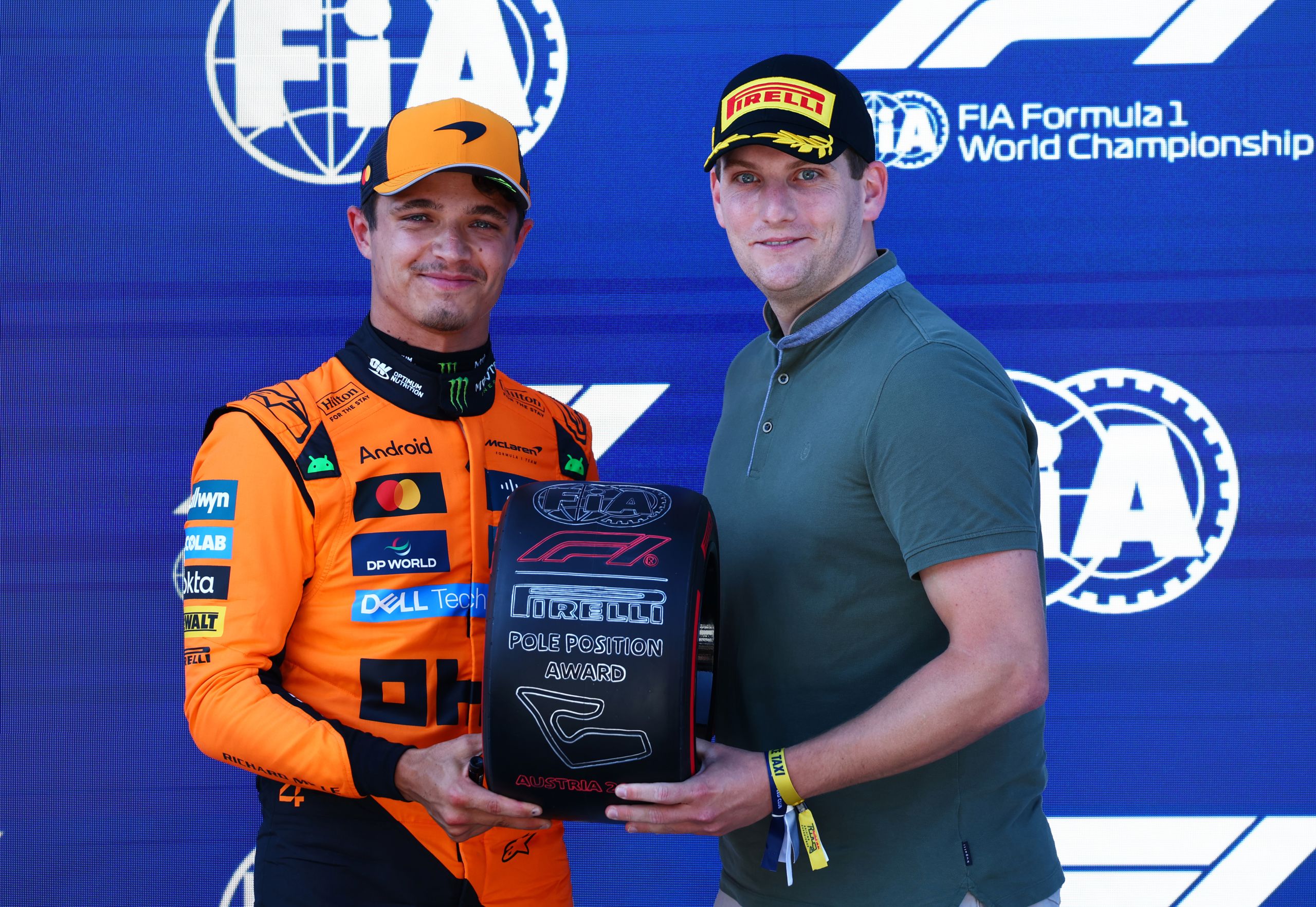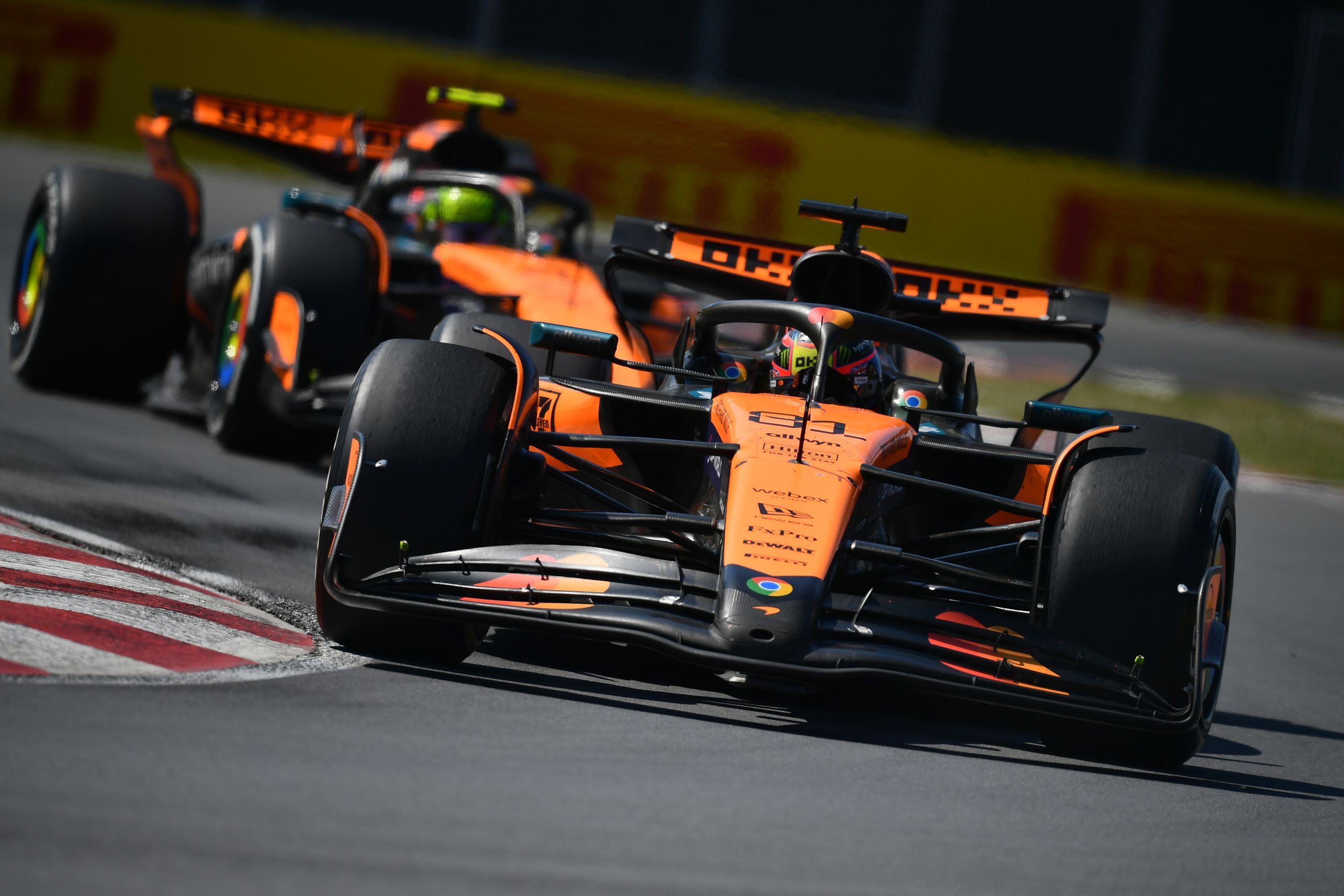The History Of Formula 1 Safety Devices: Evolution and Impact

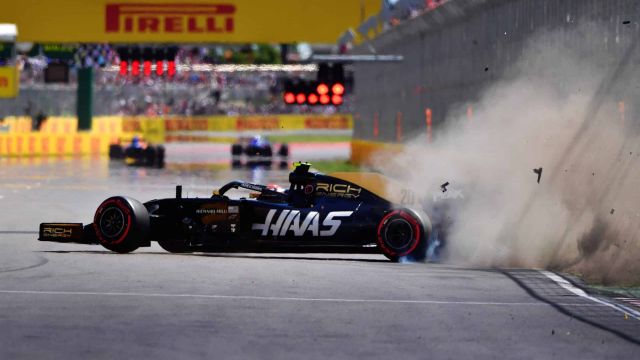
The history of FORMULA 1 safety devices goes all the way back to the inception of the sport, however, early efforts were nowhere near as effective as they are today. Thankfully, due to the ongoing work of F1 and the FIA, we now have fewer serious crashes resulting in Formula 1 deaths than we did in the 50s and 60s.
Three-time World Champion Jackie Stewart was a champion for change during the 1960s and 1970s, however, his drive to enhance safety measures was unpopular with officials and track owners.
“My quest for safety had become by far the most unpopular thing that I was faced with. I don’t think there’s a single corner of any race track in the world called Stewart corner,” said Stewart.
Many of the F1 safety measures we take for granted today came about via Stewart and the drivers of his area pushing for change. Here we look at the history of Formula 1 safety devices through the decades…
Evolution of Personal Safety Equipment
The history of Formula 1 is marked by ongoing advancements in safety equipment. Key developments particularly in helmets and fire-resistant racing suits have significantly improved the protection of drivers through the years.
Helmets and Their Advancements
Helmets have been a required safety feature for drivers since 1952, evolving from basic cork protection to advanced carbon fiber construction. These helmets have been enhanced to withstand severe impacts and resist fire. By 2001, the outer shells of helmets were produced using carbon fiber, increasing their ability to protect against head injuries. In combination with the development of full-face helmets, which included visors, drivers were better shielded from debris and the risk of facial injuries was lessened. The interior construction also progressed, with materials designed to absorb energy upon impact, safeguarding against concussions.
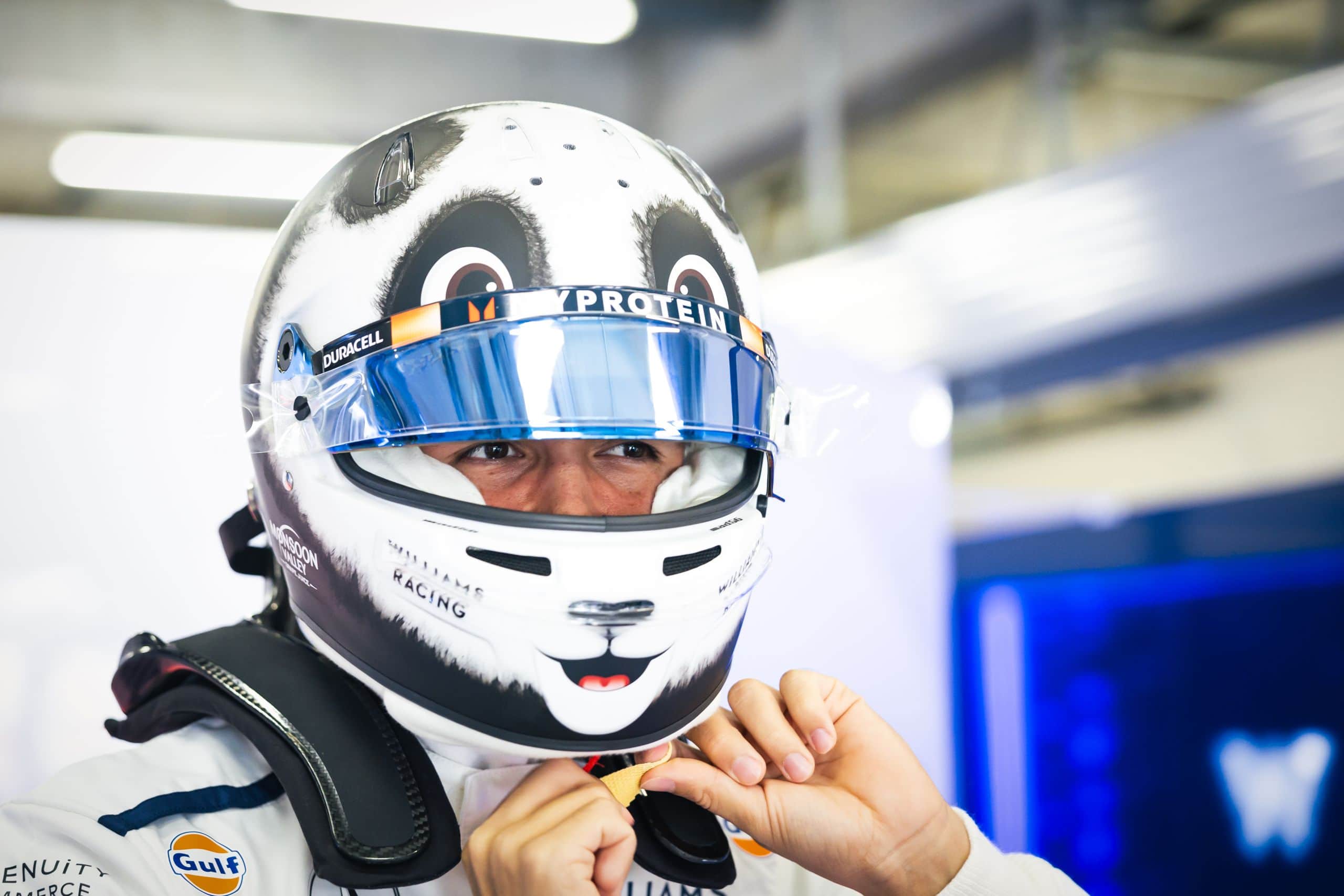
Development of Fire-Resistant Racing Suits
In contrast to the 1950s attire, which consisted of everyday clothing, advancements have brought about fully fire-resistant suits compulsory since 1975. These suits incorporate Nomex, a material capable of withstanding high temperatures, providing drivers crucial time to escape in the event of fire. The design incorporates a lightweight and breathable fabric for comfort without compromising safety. Racing gloves, introduced in 2018 with biometric sensors, added another layer of safety by monitoring the driver’s vital signs. Gloves trialled in 2021 focused on increasing fire protection, further reducing the risk of burns during an accident. The ongoing improvements in materials and design of racing suits illustrate the commitment to driver safety in Formula 1.
Safety Features in the Car Design
Formula 1 cars have evolved significantly in terms of safety features, incorporating a range of design innovations to protect drivers. The focus on the survival cell and head protection mechanisms are key examples of these advancements.
Introduction of Survival Cell
The survival cell, also known as the monocoque, is a core component in the structural design of a Formula 1 car. Introduced in 1981, the survival cell is a strong, reinforced cockpit that encapsulates the driver, and is built to withstand severe impacts. It is constructed from layers of carbon fiber and other composite materials, providing resilience against high-speed collisions. This structure ensures the driver is contained within a safe zone, drastically reducing the risk of injury during a crash.
Implementation of Headrests and Wheel Tethers
In 1996, Formula 1 introduced headrests to improve driver safety. The headrests are designed to reduce the risk of head and neck injuries in the event of an impact by absorbing energy and providing support. Crafted from a high-absorption foam, these headrests are a vital feature for driver safety.
Wheel tethers were another significant advancement, introduced in 1999. These strong cables attach the wheel assembly to the main chassis, aiming to prevent wheels from detaching during a crash and becoming hazardous projectiles. Each wheel is secured with two tethers, ensuring redundancy and enhancing their effectiveness.
The halo, introduced in 2018, is a titanium structure fitted above the cockpit. It acts as a barrier, protecting the driver’s head from flying debris and mitigating the force of impact from above. While its addition sparked debate over aesthetics and visibility, its effectiveness has been proven, credited with saving lives and preventing serious head injuries in numerous high-profile incidents.
Track and Pitlane Safety Improvements
Formula 1 has continually sought to improve safety measures on tracks and in the pitlane. These measures include the introduction of the Safety Car and the imposition of speed limitations within the pitlane to safeguard the teams and drivers.
Institution of the Safety Car
The Safety Car, first introduced in 1992, became a permanent fixture in Formula 1 racing beginning in 1993. Its primary function is to neutralize a race in the event of a significant hazard, reducing the risk of further incidents. During its deployment, competitors must follow it at a reduced speed, refraining from overtaking until the track is declared safe.
- Year of Permanent Introduction: 1993
- Purpose: Race neutralization and incident response
Regulating Speed with Pitlane Limitations
To improve safety in the pitlane, a speed limit was imposed in 1994. Initially set at 50 km/h during practice sessions, the speed limit is strictly enforced to prevent accidents involving pit crew and drivers.
- Year Pitlane Speed Limit Introduced: 1994
- Original Speed Limit During Practice: 50 km/h
Alongside these initiatives, barrier technologies and run-off areas were re-evaluated starting in 1994 to include more effective energy-absorbing systems and sufficient space to decelerate vehicles before impact.
- Year of Rework: 1994
- Focus: Energy-absorbing barriers and extended run-off areas
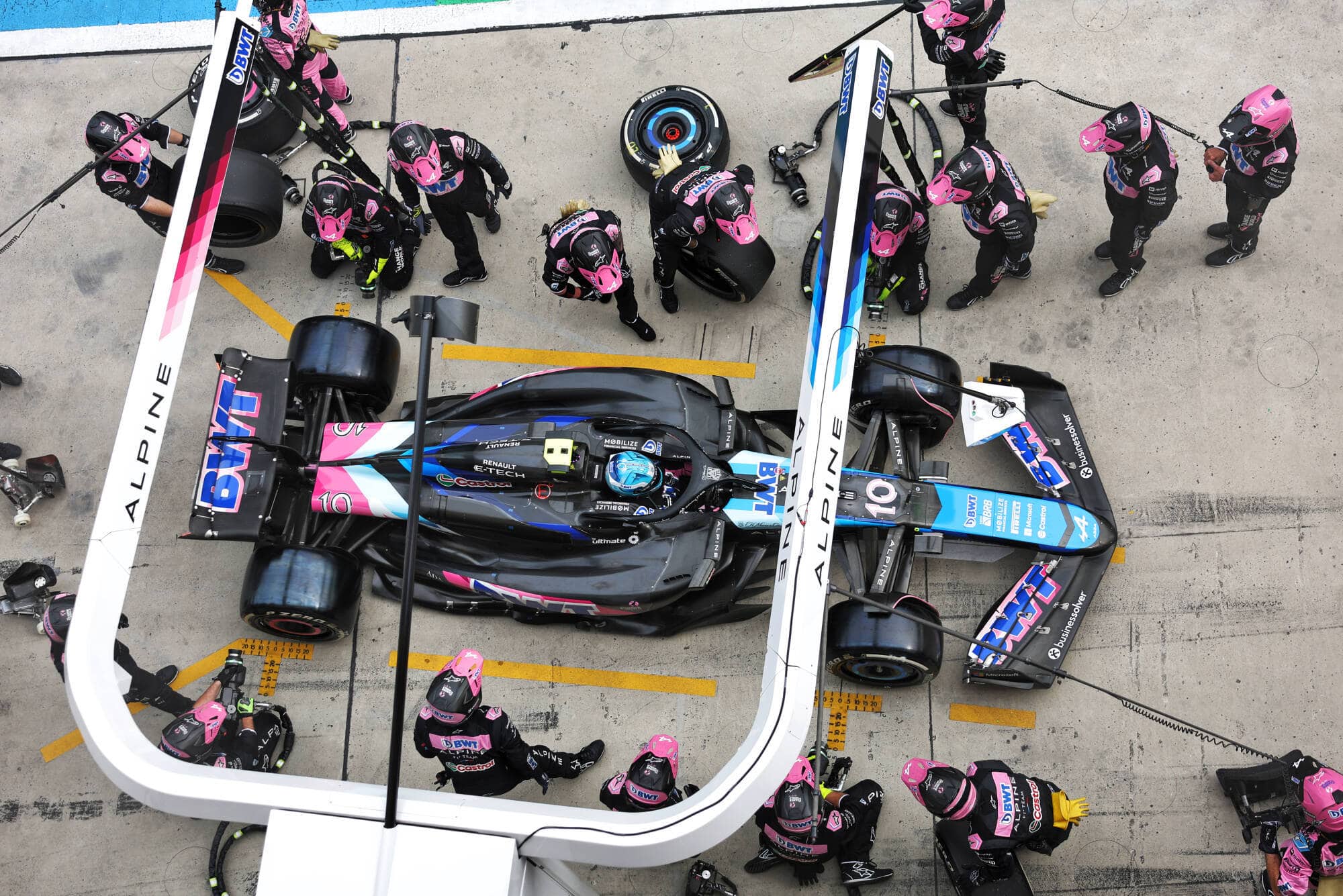
Technological Advancements in Racing Safety
Advancements in Formula 1 safety technology have significantly improved driver safety through innovative use of biometrics and analytics, alongside enhancement of protection mechanisms and performance monitoring equipment.
Biometrics and Accident Data Analysis
The Accident Data Recorder (ADR), first introduced in 1997, has been critical in analyzing crashes post-incident. By recording key vehicle parameters, it allows for precise examination of events leading up to an accident. Complementing this, the introduction of accelerometers in 2014 provided detailed data on forces experienced by drivers during crashes, further aiding in improving safety measures.
Driver Protection and Performance Monitoring
The introduction of the driver-facing camera in 2016 provided another layer to driver safety, allowing for the observation of driver behavior and condition in real-time. These cameras serve as a tool for performance monitoring and can aid in the immediate assessment of a driver’s condition following an incident. Overall, this use of technology has been pivotal in enhancing the safeguards in place for Formula 1 drivers.
Regulations and Devices for Driver Safety
Formula 1 has continuously evolved its safety standards, implementing advanced protective gear and stringent regulations to safeguard drivers’ well-being on the track.
Mandatory Safety Equipment for Drivers
Helmets: Mandatory since 1952, helmets are critical for driver safety. Advancements have led to stronger materials and better design, significantly reducing head injuries.
HANS Device: Introduced in 2003, the Head and Neck Support (HANS) device is compulsory. It minimizes the risk of neck injuries during high-speed impacts by restraining the head in relation to the torso.
Seatbelts: These evolved from basic lap belts to sophisticated multi-point harnesses, securing drivers firmly and reducing the risk of injury in a crash.
Race Suits: Fire-resistant suits, gloves, and boots are obligatory to protect drivers from fire hazards, with materials that resist high temperatures and provide additional time for escape.
| Safety Device | Description | Year Introduced |
|---|---|---|
| Helmets | Shield head from impacts and debris | 1952 |
| HANS Device | Prevent neck injuries in collisions | 2003 |
| Seatbelts | Secure driver to the seat | Early F1 years |
| Race Suits | Offer protection against fire | Pre-1960s |
Restructuring Driver Eligibility
Super Licence: Since its revision in 2016, obtaining a Super Licence, required to compete in F1, mandates meeting rigorous criteria including experience in lower racing formulas, achieving competition points, and passing an FIA theory test on racing rules and safety.
Refueling Ban: Reintroduced in 2010, the ban on refueling during races reduces the risk of pit-lane fires, thus influencing both race strategy and overall safety measures in the sport.
These developments, amongst others, represent Formula 1’s commitment to driver protection, creating a safer racing environment through a blend of equipment standards and driver requirements.
Role of Marshals in Circuit Safety
Marshals have played a critical role in F1 safety since the 1950s. They are often the first to arrive at the scene of a crash, where their primary responsibility is to manage the situation and help drivers. These individuals are trained volunteers who handle trackside operations and emergency response.
Marshals are strategically stationed around the circuit, equipped with flags to communicate vital information to the drivers, such as hazards on the track or the need to slow down. In the event of an accident, they are there to secure the area, provide immediate assistance to any drivers involved, and help with the removal of debris to protect other competitors and ensure the safe continuation of the race.
The presence of marshals is essential for a variety of reasons:
- Safety: They provide immediate on-site response, which is crucial for the well-being of drivers.
- Communication: Their use of flags and signals helps maintain a flow of information to drivers, contributing to overall track safety.
- Efficiency: Quick action by marshals in clearing the track can prevent further incidents and allow races to resume swiftly.
Their role requires a significant level of preparedness. Marshals must be vigilant at all times and able to swiftly deal with unexpected events on the circuit while maintaining a calm demeanor. Their ability to perform under pressure is an invaluable asset to the sport and contributes significantly to F1’s safety record.
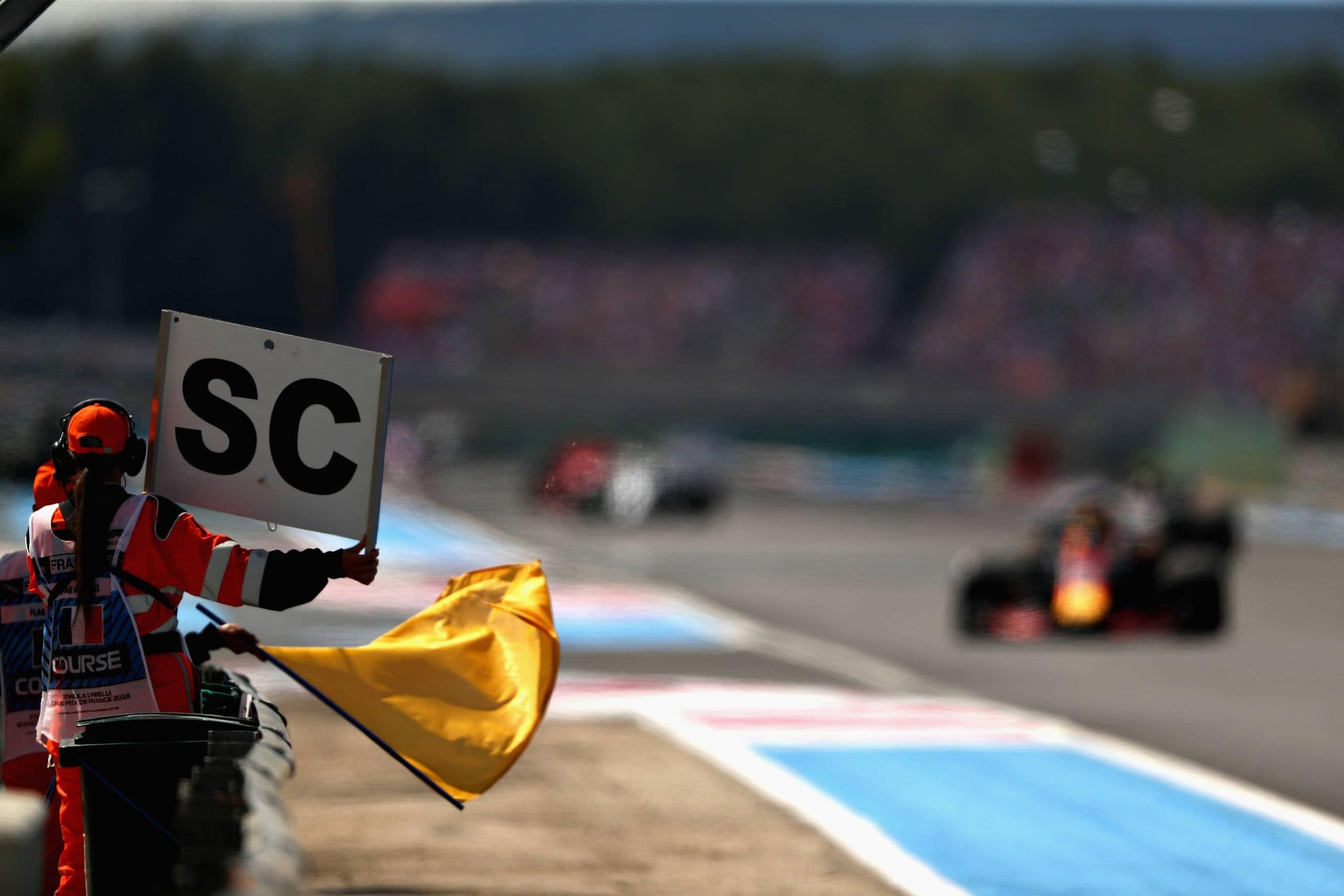
The Chronology Of Formula 1 Safety Devices
F1 Safety Devices – 1950s
1950 The first Formula One World Championship race is held at Silverstone in England. The cars were designed purely for speed, with front engines and drum brakes – a fascinating experience without medical back-up or any form of safety net.
1952 Cork helmets made compulsory by the FIA.
1955 Disc brakes are introduced, and a ‘relocation’ takes place – Australian Jack Brabham, in his Cooper, is the first Formula One competitor to drive a mid-engined, rather than front-engined, car.
F1 Safety Devices – 1960s
1960 The first safety measures are introduced to Formula One racing.
1961 Roll-overs bars are introduced for the first time.
1963 Flag signals are introduced. Vehicle fire prevention is advanced by improvements in fuel-tank construction. Double brake circuit becomes mandatory. The Federation Internationale de l’Automobile (FIA) assumes responsibility for safety on racing circuits. Drivers are required to wear fireproof suits. Cockpits are restructured to allow the drivers to get out more quickly.
1968 Interrupters for electronic systems are introduced. The roll-over bar must reach five centimetres higher than the driver’s head. Additional fireproof clothing is recommended. Dan Gurney is the first driver to use a full-visor helmet in practice for the British Grand Prix.
1969 A double fire extinguishing system is introduced.
F1 Safety Devices – 1970s
1970 For safety reasons, the fans must now be at least three meters from the track. Between the track and pit lane, a separation wall has become mandatory.
1971 In case of fire, drivers have to leave the cockpit within five seconds (tested). In 1975 fireproof clothing became mandatory.
1972 The Six-point safety harness became compulsory so that drivers wouldn’t be hurled out of cars anymore – introduced two years after Jochen Rindt’s accident in Monza in 1970.
1975 Introduction of headrest and fire extinguisher (onboard).
1978 Professor Sid Watkins became the first chief physician of Formula 1. Since then medical conditions improved more and more.
1979 The cockpit openings were increased, so drivers could leave their cars easily in emergencies. Some drivers started wearing five-layer fireproof overalls for the first time, including Niki Lauda.
F1 Safety Devices – 1980s
1980 A track hospital is introduced and from 1986 a rescue helicopter as well.
1981 The carbon fiber monocoque becomes standard equipment and is extended to the foot area.
1985 The first crash tests for the front end of the cars are introduced.
1988 From 1988 the entire monocoques are part of the crash test regulations. Over the following years, regulation is further tightened and extended to other components.
F1 Safety Devices – 1990s
1990 Larger rear-view mirrors and detachable steering wheels become mandatory. Rescue training for drivers becomes compulsory.
1991 Tests for roll-over bars, seatbelts and survival cells introduced.
1992 Introduction of the official Formula One safety car and stricter crash tests.
1993 Area of drivers’ head protection material around the cockpit is increased from 80 to 400 square centimetres. The height of the rear wing is reduced, the distance from the front wing to the ground is increased and the circumference of the steering wheel is reduced. Exotic fuel mixtures are banned.
1994 All members of the refuelling crew must wear fireproof clothing. The FIA assigns a team of experts to check how Formula One racing can be made safer by means of new technologies. Auxiliary driving aids such as traction control, ABS, power-assisted brakes and automatic transmissions are prohibited. The FIA uses computer analysis to identify 27 particularly dangerous corners that have to be made safer. Test procedures for tyre barriers become mandatory, and barriers must also be secured by rubber belts. The speed limit in the pit lane is reduced to 80 km/h in practice and 120 km/h in races. The production standard for helmets becomes stricter.
1995 Crash tests become stricter and lateral crash tests are introduced. The FIA introduces new criteria for the acquisition of an F1 super license.
1997 FIA accident data recorders are installed in all cars for more precise accident analysis. A rear impact test and new rear crash structures are made compulsory. Tyre barriers have to be bolted down.
1998 Car width is reduced from 2 to 1.8 metres. Cockpits are enlarged. A driver must be able to detach the steering wheel, exit the cockpit and reattach the steering wheel, all within ten seconds. Rear-view mirrors must be at least 120×50 millimetres.
1999 Wheels are attached to the chassis by tethers to stop them from flying off during accidents.
The seat and driver can be removed together. Front crash tests become stricter. Asphalt instead of gravel is used for some run-off areas. Four medically-equipped rescue vehicles and a car for the FIA doctor are made compulsory.
F1 Safety Devices – 21st Century
2000 The impact speed in a frontal crash test increases from 13 to 14 meters per second. The carbon fibre walls of the cockpit must be at least 3.5 millimetres thick.
2001 The cockpit walls are built higher.
2002 Because in 2000 at Monza and 2001 in Melbourne two marshals die from flying tires, each wheel now gets two tethers.
2003 The head-and-neck support system (HANS Device) is introduced. It stabilizes and protects the head and neck of the driver in accidents.
2005 The protective cushions in the cockpit are strengthened. The tire tethers now need to withstand forces of up to six tons. Front wings and other aerodynamic components must be built with extra hard kevlar.
2006 For the first time, Tecpro barriers are being experimented as a track boundary. The plastic blocks absorb 40% more energy than conventional tire stacks.
2008 Cockpit walls are further heightened by 5 cm.
2011 After Felipe Massa’s accident in Hungary in 2009, the helmets must have a Zylon band attached above the visor that protects the pilots from flying parts.
2013 Helmets become compulsory for all who work on the car during the race. Only team members and marshals can be in qualifying and racing in the pit lane
2015 Complete chassis with Zylon protection – bulletproof protection.
2016 After Jules Bianchi’s deadly crash with an excavator in Suzuka, the virtual safety car phase is introduced.
2018 Three instead of two kevlar tethers for tires are introduced.
2018 HALO introduced to F1 cars



